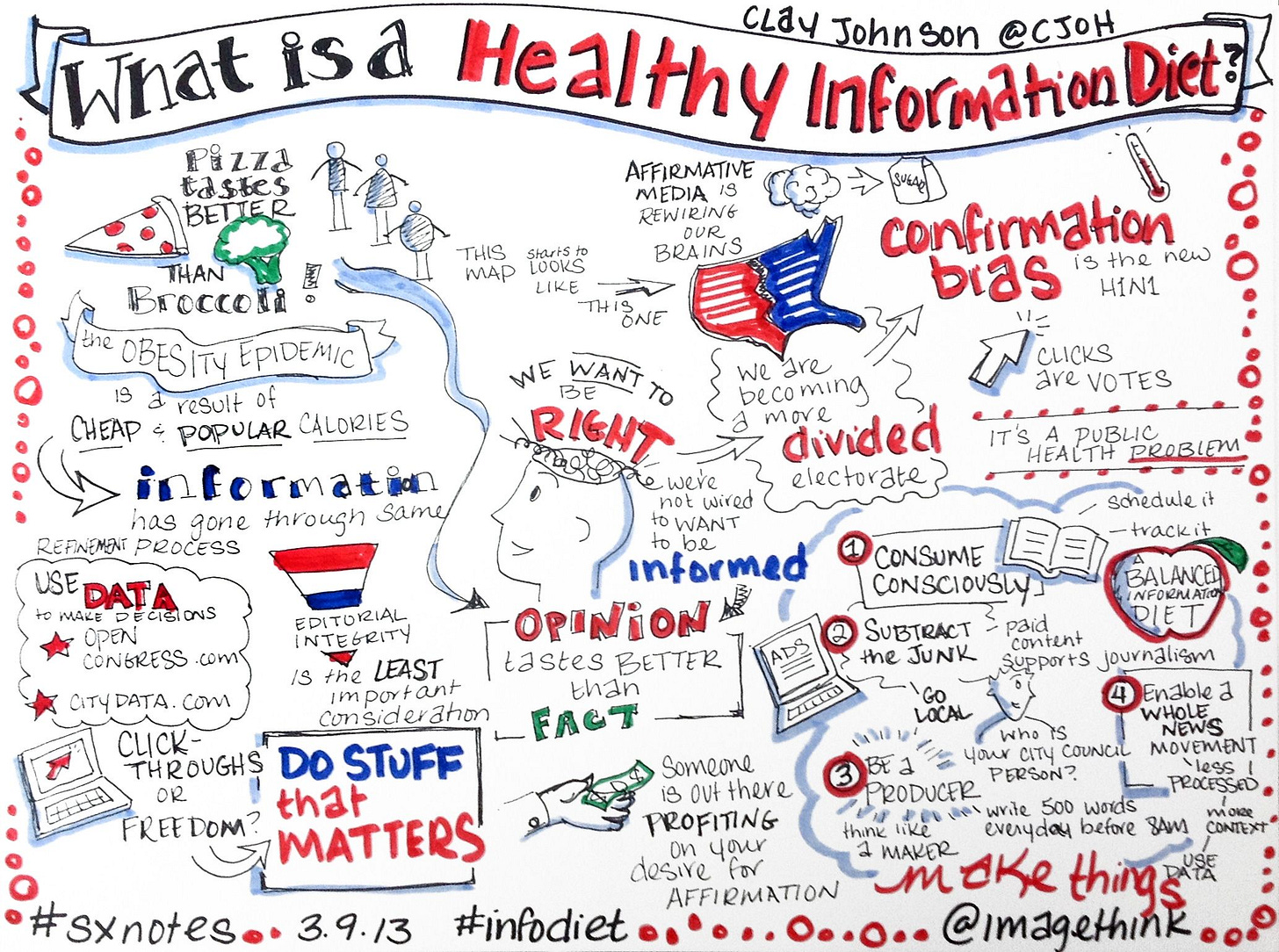Friday Notes, May 10, 2024
Dear Friends —
Information is food for our brains; what we read, watch, and listen to is our media diet. Extending that metaphor:
We need a balanced media diet, not all from one source and not all of one flavor. Some savory and some sweet.
We have to consume some media, but not too much.
Just like we can maintain vegetarian or gluten-free regimens, with a little discipline we can exclude some information inputs from our diet to improve our health.
On balance, local is better; there’s a greater chance that we know how it’s made, and even the people who make it. The further away the source, the less we know about whether to trust what we’re consuming.
Our information sources can be contaminated, accidentally or intentionally. And we might not be able to detect the toxins until it’s too late. If we’re cooking — creating content — we might even use tainted ingredients without knowing.
Here’s a prediction: In a couple of years, academics who study the malign use of social media by the Russian government are going to reveal that we are in the midst of an active — and successful — trolling enterprise designed to intensify and amplify division within U.S. progressive communities around Israel.
I say this with a lot of confidence and a lot of worry. It’s just not that hard to put the pieces together — to see the schism-making on the political left as part of a repeating pattern, and to realize that creating or augmenting an association between Palestinian rights and anti-Semitism would be too big an opportunity for the Bad Guys to pass up. It is also painfully obvious that many well-intentioned people are serving as “useful idiots,” influenced by inauthentic messages created to manipulate and converting them into authentic ones in their own voices.
While it may take scholars time to find the threads of accountability, the problem we’re seeing is anything but academic. We’re watching — and watching the fierce debates about — civil and uncivil disobedience on campuses, and extreme responses by those in power. For months now, we have seen some Jewish-identified funders using the power of the purse to protest allegedly anti-Semitic positions taken by nonprofit organizations and universities. (As context, by some estimates fully half of the largest philanthropic funders in the U.S. are Jewish-identified.) We’ve seen nonprofit organizations torn apart by competing narratives and the choices of words in public statements. Fault lines are shaking up synagogues and families. We’ve seen politicians and others in public life struggle to find a position that doesn’t alienate people who identify with a “pro-” or an “anti-” side. At a time that calls for unity and solidarity around fundamental human rights and peace-building, these fractures are the real enemy.
This is not happening by accident.
Do you remember what happened to the Women’s March, and the broader feminist movement, after the 2016 election? It foreshadows what we are seeing now.
Building on work by Samantha R. Bradshaw, a disinformation expert, in 2022 the New York Times explained how Russia created a trolling campaign on social media to discredit a Palestinian activist, Linda Sarsour, and inflame fears of anti-Semitism. That campaign poured gasoline on the Jewish community’s always-in-the-background fear about anti-Jewish hate, and succeeded in blowing up a coalition of women who had come together to organize against the likely policy moves and judicial appointments of the newly inaugurated President Donald Trump.
Here’s a fragment of the story:
A fragile coalition to begin with, [the Women’s March] headed into crisis over its co-chairs’ association with Louis Farrakhan, the Nation of Islam leader, who is widely condemned for his antisemitic statements. When this surfaced, progressive groups distanced themselves from Ms. Sarsour and her fellow march co-chairs, Carmen Perez, Tamika Mallory and Bob Bland, and some called for them to step down.
But there is also a story that has not been told, one that only emerged years later in academic research, of how Russia inserted itself into this moment.
For more than a century, Russia and the Soviet Union sought to weaken their adversaries in the West by inflaming racial and ethnic tensions. In the 1960s, K.G.B. officers based in the United States paid agents to paint swastikas on synagogues and desecrate Jewish cemeteries. They forged racist letters, supposedly from white supremacists, to African diplomats.
They did not invent these social divisions; America already had them. Ladislav Bittman, who worked for the secret police in Czechoslovakia before defecting to the United States, compared Soviet disinformation programs to an evil doctor who expertly diagnoses the patient’s vulnerabilities and exploits them, “prolongs his illness and speeds him to an early grave instead of curing him.”
A decade ago, Russia’s president, Vladimir V. Putin, oversaw a revival of these tactics, seeking to undermine democracies around the world from the shadows . . . . Social media now provided an easy way to feed ideas into American discourse, something that, for half a century, the K.G.B. had struggled to do.
There is no doubt that horrific acts have taken place, are taking place, in the war between Israel and Hamas. There is no doubt that the war reflects continuous oppression and aggression that has a long-ago origin and no obvious means of resolution. There also is no doubt that Jewish people and communities have experienced hate and discrimination for millennia, and occasionally existential threats. These are real things around which opinions and disagreements can form, and protests and counter-protests can be made manifest.
Those opinions and disagreements, real as they may be at the start, have been churned and spewed and broadcast with ever-greater intensity and tendency toward personal attack. The very human responses of outrage, fear, and tribal bonding have kicked in. That’s how we know the trolls are at work, united in their mission to divide.
What I Have Learned So Far:
by Mary OliverMeditation is old and honorable, so why should I
not sit, every morning of my life, on the hillside,
looking into the shining world? Because, properly
attended to, delight, as well as havoc, is suggestion.
Can one be passionate about the just, the
ideal, the sublime, and the holy, and yet commit
to no labor in its cause? I don’t think so.All summations have a beginning, all effect has a
story, all kindness begins with the sown seed.
Thought buds toward radiance. The gospel of
light is the crossroads of — indolence, or action.Be ignited, or be gone.
Here is some solid-gold advice for dads about how to make the most of Mother’s Day (#mental_load).
Have a good weekend,
-Ruth




